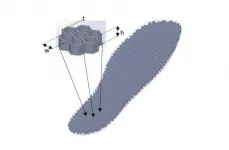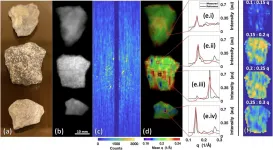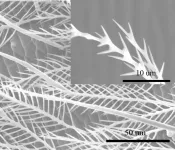Smokers needed angioplasty and stenting a decade before non-smokers
2021-06-09
(Press-News.org) Smokers needed their blocked arteries fixed nearly a decade earlier than non-smokers, and patients with obesity underwent these procedures four years earlier than non-obese patients, according to a new statewide study.
The research included patients without a history of heart attack who were treated at hospitals across Michigan participating in BMC2, the Blue Cross Blue Shield of Michigan Cardiovascular Consortium. The patients had undergone angioplasty and/or stenting to widen or unblock their coronary arteries and restore blood flow. Almost all of them had at least one traditional risk factor, including smoking, obesity, high blood pressure, high cholesterol and diabetes. Most had three or more.
Additionally, women generally had their first procedure at a later age than men. Over the past decade, among patients undergoing their first angioplasty or stent procedure, the rates of obesity and diabetes have increased, while smoking and high cholesterol have decreased.
"Smoking is a completely preventable risk factor," said senior author Devraj Sukul, M.D., M.Sc., an interventional cardiologist and a clinical lecturer at the University of Michigan Health Frankel Cardiovascular Center. "If we direct additional efforts at preventing smoking and obesity we could significantly delay the onset of heart disease and the need for angioplasty and stenting."
Smoking cessation is a growing focus of the Michigan Collaborative Quality Initiatives, of which BMC2 is a member.
"In Michigan, we will work to help every smoker quit at the time of cardiac care because it is an unmatched teachable moment for patients," said Michael Englesbe, M.D., a surgeon and professor at Michigan Medicine who serves as portfolio medical director for the Collaborative Quality Initiatives.
Sukul also serves as associate director of BMC2's work in percutaneous coronary intervention.
INFORMATION:
ELSE PRESS RELEASES FROM THIS DATE:
2021-06-09
Millions of people with diabetes are at risk of developing foot ulcers, which often lead to amputations and other health complications. Now, Scientists from the Centre for Biomechanics and Rehabilitation Technologies (CRBT) have developed a new method to reliably detect this risk without the need for complex electronic in-shoe sensors.
Dr Panagiotis Chatzistergos, Associate Professor in Orthopaedic Biomechanics, explained: "In the UK alone, 169 people have a toe, foot or limb amputated as a result of diabetes every week, yet importantly up to 80% of these amputations could have been prevented with correct management.
"Routine overloading ...
2021-06-09
New research shows what is often assumed to be 'fair' in conservation practice may not be considered so by the very people most affected by it--and a new approach is needed if protected areas are to be effective.
Lead author Dr Georgina Gurney, from the ARC Centre of Excellence for Coral Reef Studies based at James Cook University, said considering local stakeholder conceptions of fairness in conservation is critical.
"If conservation is perceived as unfair it can lead to conflict, undermining support and cooperation," Dr Gurney said.
She said it is not only an ethical matter but key to achieving good ...
2021-06-09
University of Illinois Chicago researchers studying birth outcomes in marmoset monkeys found there were no adult maternal characteristics like age or weight gain during pregnancy to predict stillbirth or early neonatal death, but that a mother's birth weight or litter size were associated with early neonatal death.
"Our findings of early life contributions to adult pregnancy outcomes in the common marmoset disrupt mother-blaming narratives of pregnancy outcomes in humans," the paper states.
Julienne Rutherford, associate professor at UIC's School of Nursing, is lead author of "Womb to Womb: Maternal litter size and birth weight but not adult characteristics predict early neonatal death of offspring in the common marmoset monkey" published in the journal PLOS ONE.
Marmosets ...
2021-06-09
Since the early days of the COVID-19 pandemic, there were questions about how people in active cancer treatment would fare if they became infected with SARS-CoV-2. The worries were due, in large part, to the effects that cancer and its treatments can have on the immune system. Now that COVID-19 vaccines are widely available, concerns have shifted to the safety and effectiveness of vaccination in this potentially vulnerable population. A study published June 5 in the journal Cancer Cell aims to allay those fears.
In a review of 200 patients with a wide spectrum of cancer diagnoses, researchers at Montefiore Health System and Albert Einstein College of Medicine in the Bronx, NY, found that after full vaccination, 94% of patients overall demonstrated seroconversion, ...
2021-06-09
The routes and schedules of public transit, the presence or absence of sidewalks, the availability of different transportation options, and the design of highways that divide cities--these are examples of aspects of transportation systems that can profoundly impact underserved communities' access to basic needs like jobs, health care, education and even food.
A new study by University of Michigan researchers reveals common barriers that transportation decision-makers face in considering these issues and addressing them.
To conduct the study, a team from a multidisciplinary project involving engineering, ...
2021-06-09
DARIEN, IL - A study shows that a deep neural network model can accurately predict the brain age of healthy patients based on electroencephalogram data recorded during an overnight sleep study, and EEG-predicted brain age indices display unique characteristics within populations with different diseases.
The study found that the model predicted age with a mean absolute error of only 4.6 years. There was a statistically significant relationship between the Absolute Brain Age Index and: epilepsy and seizure disorders, stroke, elevated markers of sleep-disordered breathing (i.e., apnea-hypopnea index and arousal ...
2021-06-09
The widely studied metallic asteroid known as 16 Psyche was long thought to be the exposed iron core of a small planet that failed to form during the earliest days of the solar system. But new University of Arizona-led research suggests that the asteroid might not be as metallic or dense as once thought, and hints at a much different origin story.
Scientists are interested in 16 Psyche because if its presumed origins are true, it would provide an opportunity to study an exposed planetary core up close. NASA is scheduled to launch its Psyche mission in 2022 and arrive at the asteroid in 2026.
UArizona ...
2021-06-09
[RALEIGH, N.C.] - How are the squirrels doing this year? The bears? The armadillos? How would you know? A new paper published June 8 sets up the framework for answering these questions across the United States by releasing the data from the first national mammal survey made up of 1,509 motion-activated camera traps from 110 sites located across all 50 states.
Unlike birds, which have multiple large-scale monitoring programs, there has been no standard way to monitor mammal populations at a national scale. To address this challenge, scientists from the North Carolina Museum of Natural Sciences and the Smithsonian Conservation Biology Institute recently collaborated ...
2021-06-09
DURHAM, N.C. - Engineers at Duke University have demonstrated a prototype X-ray scanning machine that reveals not just the shape of an object but its molecular composition. With unprecedented resolution and accuracy, the technology could revolutionize a wide range of fields such as cancer surgery, pathology, drug inspection and geology.
Many of the ideas behind the prototype were originally conceived in the pursuit of performing better bomb detection for aviation security. In the new paper, published online May 19 in the journal Scientific Reports, the researchers adapted the technology for several targeted scientific and medical applications.
"Whether you're trying to spot a bomb in a bag or a tumor in a body, the physics is more or less the same," said ...
2021-06-09
Watching honeybees buzz among flowers, it's easy to see how the expression "busy as a bee" arose. One of many movements a bee's body makes is the repetitive curving and straightening of its abdomen. Now, researchers reporting in ACS Applied Materials & Interfaces have found that tiny hairs reduce friction from these motions, saving energy for the industrious insects' daily activities while reducing wear and tear. This knowledge could help researchers design longer-lasting moving parts.
A bee's abdomen is divided into several tough outer plates that make up its exoskeleton. When the abdomen flexes and extends, these segments slide over each other, creating friction. However, the overlapping portions of the segments show very little wear and tear, ...
LAST 30 PRESS RELEASES:
[Press-News.org] Smokers needed angioplasty and stenting a decade before non-smokers




